Technical Information
If you are wondering how something works or just want to dive deep and nerd out over Orange, you have found the right place!Dating Orange Amplifiers
You can use this guide that we have put together to help date your Orange Amplifier. Please keep in mind that there are always odd ball amps or transitional amps that pop up that were built using different parts during a model transition period. Those can be more difficult to date sometimes or not necessarily fit this chart although this should get you very close. One of the most bizarre transition amps I’ve ever seen was a 1979 Series II Super Bass built using a 1974 OR120 chassis with a serial number 11XXX. If your amplifier has the original capacitors in them, you can also get a rough build year based on those dates.We have found it a little harder to date Oranges transistor or solid state amplifiers and they do not follow this guide. We want to make a note that the Orange Matamp Era is often considered to be from 1968-1971. It’s easy to understand why as the Orange/Matamp partnership ended in 1971 and you tend not to see the Orange/Matamp logo after this point. Although the partnership ended, we know Matamp from time to time would still build amps or other equipment for Orange until the Cooper Mathias Ltd was officially dissolved, which was sometime in 1975. So, we consider the Orange Matamp Era to be from 1968-1975. We even have a PA200 with the Orange/Matamp Logo in our collection that is signed and dated October 4th, 1973 by Mat Mathias. Without the date and signature found inside, I would have assumed this particular amp to be built before 1971 as the faceplate has the Orange/Matamp logo. So again, It wasn’t always straight forward with Orange and being able to date equipment, sometimes you really have to take a closer look. To date your amplifier we use the serial number on the metal chassis not the number that is stamped on the back of the wood head shell vent panel.Remember what we learned from the Orange | Matamp section, HH and Howell’s were also building ORST50 and OR100 amps to help keep up with the demand.1968-1969 Orange | Matamp - Prototype OR100 - 50 were made. The first 6 went to Fleetwood Mac for their U.S. Tour. Built with an aluminum chassis and used 2xKT88 valves instead of the 4xEL34 layout we are used to seeing in the OR100s.1969-1971 Orange | Matamp | HH Electronics | Howell’s Radio - ORST50/OR100 - Orange/Matamp logo - Traffolyte Panel - XXX - 3 digit serial number1969-1971 Orange | Matamp - OR200/PA200/SL200 - Orange/Matamp logo - Traffolyte Panel - XXX - 3 digit serial number1972-1973 Orange | Matamp - OR200/PA200/SL200 - Orange or Orange/Matamp logo - Traffolyte Panel - XXX - 3 digit serial number1971-1975 Orange | Matamp - 6 Channel PA100/PA200 & Solid State Mixers - Orange | Matamp, Orange VOTW, Orange logos - Plexi & Styrene Panels - XXX - 3 digit serial number1972-1975 Orange | Matamp - OR50/OR100/PA100/SL100 - Orange Plexi Pics Only, Metal Pics Only & Metal Pics & Text Panels (will not say Matamp anywhere) - XXX - 3 digit serial number1971-1972 Orange | Matamp - GRO50/GRO100 - Plexi Pics Only Panel Black Crest Logo (will not say Matamp anywhere) - XXX - 3 digit serial number1972-1973 Orange | Matamp - GRO50/GRO100 - Metal Pics Only or Metal Pics & Text Panel (will not say Matamp anywhere) - XXX - 3 digit serial number1970-1971 Orange - ORS50 - Plexi Pics Only Panel Cream/Off White Crest Logo - 4XXX - 4 digit serial number1970-1971 Orange - ORS100 - Plexi Pics Only Panel Cream/Off White Crest Logo - 9XXX - 4 digit serial number1970-1971 Orange - SL100 Solid State - Orange logo - Traffolyte Panel - 1XXX - 4 digit serial number1971-1972 Orange - PA120/SL120 - Plexi Pics Only Panel Black Crest Logo - XXX - 3 digit serial number1971-1973 Orange - OR80 - Plexi Pics Only Panel Black Crest Logo or Metal Pics Only Panel - XXXX - 4 digit or 80XXX - 5 digit serial number1971-1973 Orange - OR120 - Plexi Pics Only Panel Black Crest Logo or Metal Pics Only Panel - XXXX - 4 digit or 120XXX - 6 digit serial number1973-1978 Orange - SL200 Solid State 103T - Pics & Text Panel - XXXX - 4 digit serial number1973 Orange - OR80/OR120/PA120/SL120 - Metal Pics and Text Panel - 10XXX - 5 digit serial number1974 Orange - OR80/OR120/PA120/SL120 - Metal Pics and Text Panel - 11XXX - 5 digit serial number1975 Orange - OR80/OR120/PA120/SL120 - Metal Pics and Text Panel - 12XXX - 5 digit serial number1975-1978 Orange - 125/129 Custom Reverb Twin Combo & Heads - 4 digit serial number1976 Orange - OR80/OR120/OR80M/OR120M/PA120/SL120 - Metal Pics and Text Panel - 13XXX - 5 digit serial number1976-1979 Orange - 6 Channel PA120 with Reverb - Text Only Panel - 13XXX-016XXX 5/6 digit serial number1977 Orange - OR80/OR120/OR80M/OR120M/PA120/SL120 - Metal Pics and Text Panel - 14XXX - 5 digit serial number1978 Orange - OR80/OR120/OR80M/OR120M/PA120/SL120 - Metal Pics and Text Panel - 15XXX or 015XXX - 5/6 digit serial number1979 Orange - Overdrive Series Two/Hustler/Super Bass- Metal Text Only Panel -16XXX or 016XXX - 5/6 digit serial numberDating Cabinets
It can be a more difficult task to date the cabs. If it has an Orange Matamp badge it’s likely from 1968-1971. If it has an Orange Voice of The World badge, it is likely from 1971-1972. From 1973 to 1978 you would normally see the 2 piece logos with the Crest badge above the Orange badge. Cabs built in 1979 have a very different look, usually a black grill cloth with a distinctly different Series II plastic corner protector. The 4x12” cabs had front loaded speakers compared to the traditional rear loaded cabs we are used to seeing.One of the best ways to date a cab is to look at the speakers and see if they seem to be Original to the Cabinet. You can then date the speakers which will tell you fairly closely to when the cab was built.Another way to possibly date Orange cabs is by the first digit in the serial number. In my experience this has been fairly accurate and has matched the speaker date code and time line of the cab itself, but it’s not a guarantee. I have also seen some that don’t make sense at all. For example: 7534 would be 1977, 4578 would be 1974 , 1337 would be 1971 etc…As far as 4x12” cabinets go, the handles are another feature you can take a look at to help date it. Some early Orange Matamp cabs didn’t have handles at all. Others had small cut out handles. Some had the small cut out handles but fitted with plastic inserts. The Voice of The World transition cabs and even some of the early 2 Piece badge cabs had the small cut out handles as well. By sometime in 1973 they were using the larger bar style handles we are used to seeing. Some of these handles were metal and some were made of plastic. Orange did continue to use the small cut out handles throughout the 70’s on other cabs like the 2x12” and 2x15” reflector but often fitted them with a small plastic insert. See the examples below.You can do a quick assessment of the Orange tolex/vinyl to at least get a rough idea of the build time frame. Orange used 3 types of tolex/vinyl from 1968-1979 to cover their equipment. Early on in the Orange Matamp days they sometimes used a thicker tolex. They also used the standard tolex most of us are used to seeing from 1969 to about 1976. Sometime in 1976 they switched and started using a third style of tolex. See all three examples below.Need replacement handles for your Orange cabinet? Check out this link to Scumbacks website.

Tolex that was used on some of the earliest Orange Matamp cabs

Tolex used from 1969 to about 1976

Tolex used from about 1976 through 1979
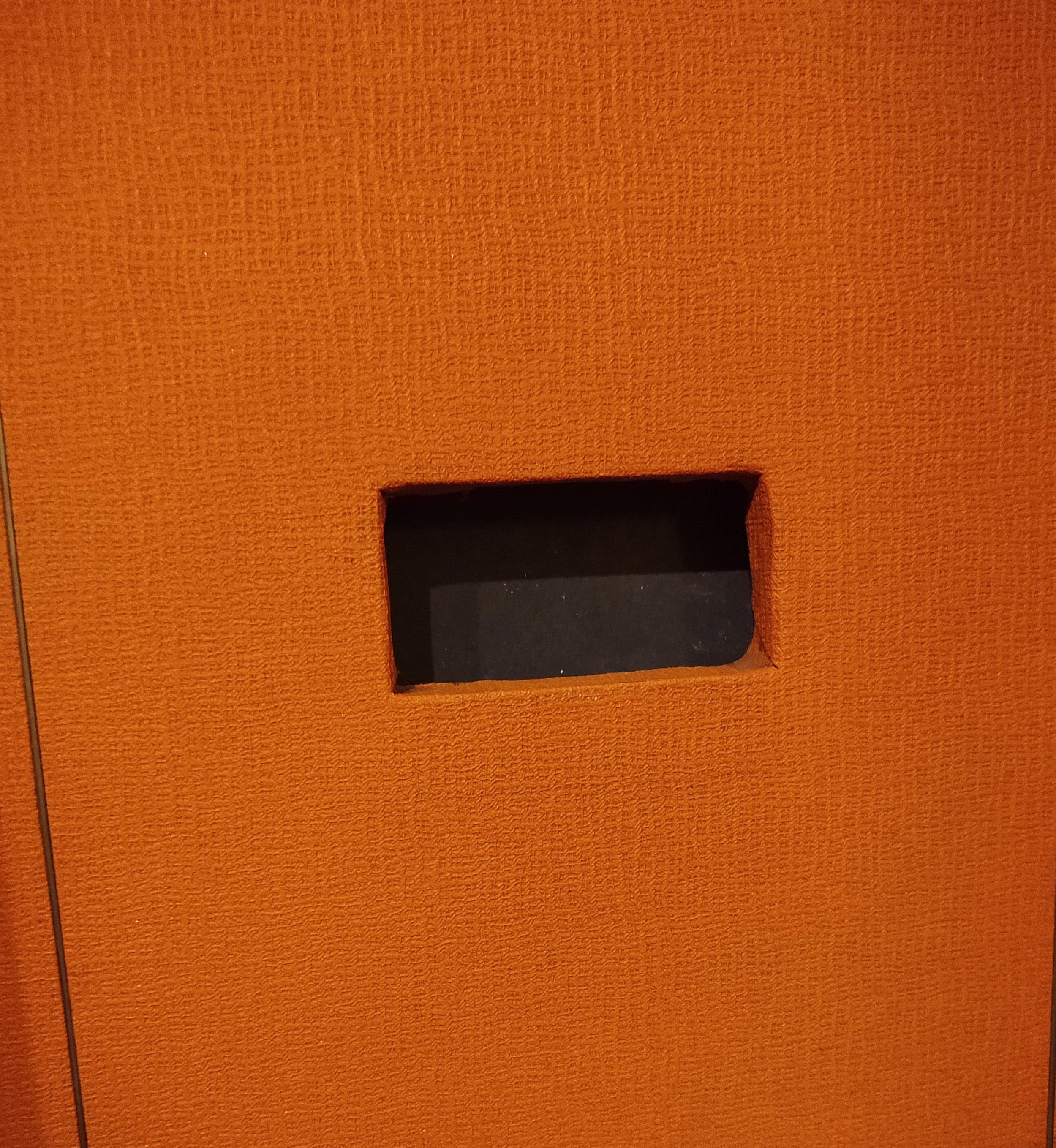
Small cut out box style handle

Small cut out box style handle with plastic re-an insert

Bar style handle, some were metal and some plastic
Modern vs Vintage Cabinets
If you are ever looking at an Orange cabinet and are having trouble figuring out what era of it’s from, here are some details to help you figure out whether your dealing with a vintage cabinet from the 70’s, a cabinets form the 90’s or a more modern Orange cabinet. You can asses the corners, input jacks and the badges to quickly help you identify the cabinet.
Late 60's, 70's and 90's - 2 pin style plastic corner

1979 Series II style plastic corner
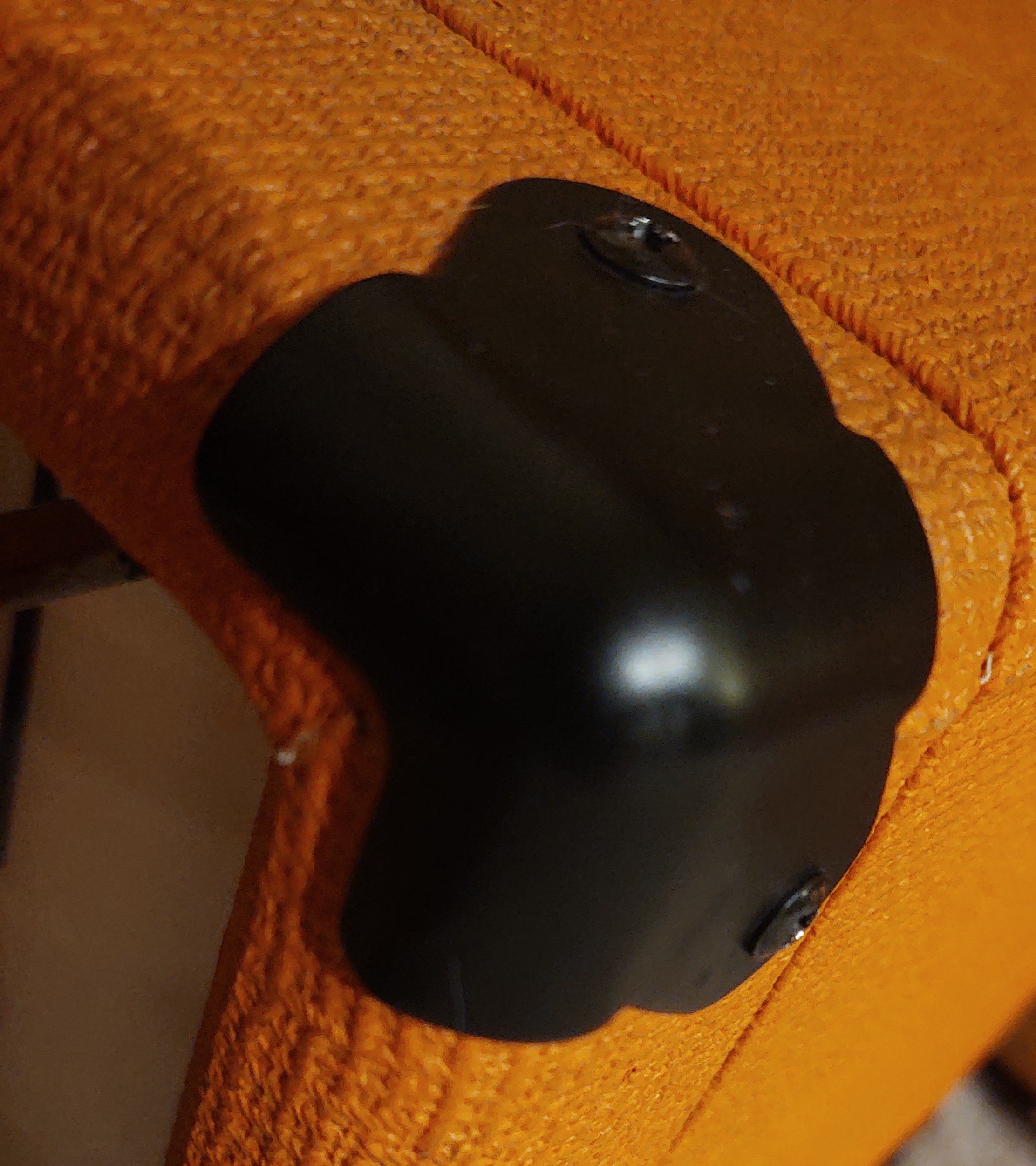
Modern metal corner

Some Orange Matamp gear used the 1 pin style plastic corners

70's style plastic input jack

90's style plastic input jack

Modern metal input jack
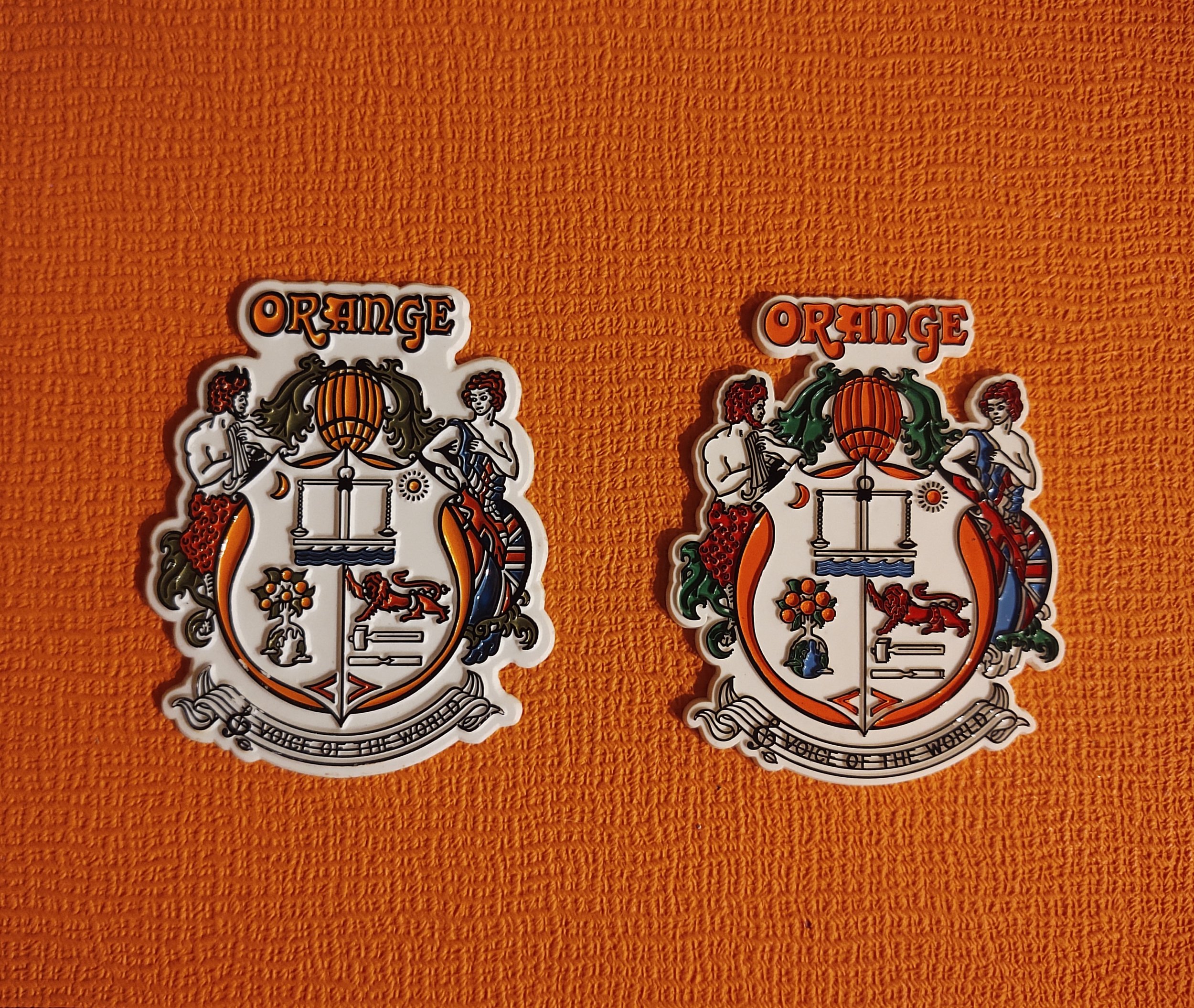
Left: Modern - Right: Vintage | Notice the vintage badge is cut out more around the word Orange.

90's cab handle
Orange Effects
Orange Effects from the 70s. These are pretty rare and hard to find. They are all pretty cool and sound great!Orange | Matamp - Thin case Early 70s Reverb Unit with volume and depth onlyOrange | Matamp - Thick case Early 70s Reverb Unit with clean feed switchOrange - Mid 70s Reverb UnitOrange - Sustain / Distortion / Phazer PedalsJimmy Bean - Voice Box (pictured left is an Orange prototype)How do I know If I have a Matamp built Orange?
It’s easy to tell the early Matamp built amplifiers as anything from 1968-1971 carried the Orange/Matamp Logo and was built in Huddersfield.By the end of 1971 after the split of the two companies, Orange was already building their own amplifiers. They started building them around 1970 at a small facility called Shorts Gardens in London but still sub contracting to Matamp as well. The first guitar amplifier models Orange designed were the GRO50/100 and ORS50/100. From what I’ve seen the GRO50/100 models look to all be built by Matamp where as the ORS50/100 along with the PA120/SL120 look to be the first amps built by Orange themselves. The ORS50/100s are probably the rarest models to come by as they were produced for a very short period of time and to a very high quality. After the small run of ORS50/100s Orange released the more popular OR80/120.Although Orange had their own amp designs and facility, from 1972-1975 Matamp would continue to produce some amplifiers and other equipment for Orange. There is always the chance of a build after this time period as well, you never know what you might find. During this time amplifiers built by Matamp would no longer have Matamp as part of the Orange logo except some OR200s, PA200s, and Slave200s might still have an Orange/Matamp logo, while others said Orange. I believe all the 200s to be built by Matamp. The OR/PA/SL-80/120s could be built by either company. There are several indicators that you can look for inside an Orange amp from 1972-1975 that would indicate it was built by Matamp versus one of the Orange factories. If you are really lucky you might have one that is signed by Mat himself which would be a dead give away where it was built! Another marking often found is D.K. Dixie Kidd was a guitar player that helped Mat at Matamp. Things you can look for are: They have a 3 digit serial number. The serial number will be scribed or written instead of stamped on the back of the chassis in the normal location we are used to seeing it. Often the serial number is also written somewhere else on the chassis and usually on the tops of the power caps (if original). The model on the back of the chassis will read OR50/100 instead of OR80/120 or SL100 instead of SL120. The brand of transformers used (Pennine vs Parmeko), sometime they have black covers but not always. They will be stand up style transformers, the laydown style are Orange builds. The output transformer will be located slightly more forward on the chassis keeping the power and output transformer in line versus offset like Oranges chassis’. Matamp used Pennine mains or power transformers that gave you 110v/118v/220/240v options while Orange used Parmeko transformers that gave you 115v/200v/220v/240v options. Matamp builds will also feature a 100v line option on the output selector. Depending who built it at Matamp the wiring inside is sometimes done very neatly and precise. I know a lot of people think if it was built at Matamp that it would have the Orange/Matamp rear badge on the head shell but that isn’t usually the case with these amps. They will have the normal Orange/London rear badge even if it was a Matamp built chassis. During this era from 68-75 Matamp Built most all of the PA/DJ equipment with the exceptions being the PA120 & SL120s, Orange made plenty of those as well.In this first picture, the Orange build is on top and the Matamp on bottom.Note all the things I mentioned above. Model Number SL120 vs SL100. Serial No. is painted or stamped vs hand scribed. Matamp will always be 3 digit hand scribed. I realize in this example both amplifiers are 3 digit. The orange just happens to be a very early 3 digit painted example, the majority of Oranges have a 5 digit stamped serial number.Mains Transformer taps: Parmeko 115/200/220/240v vs Pennine 110/118/220/240v.Output Transformer taps: Matamp builds will have a 100v line option, Orange builds do not.In this second picture, the Matamp build is on the top and the Orange build is on the bottom.Note the things I mentioned above.Serial number written by hand in various places.Brand of transformers used. Matamp using Pennine (sometimes painted black) vs Orange using Parmeko.Output Transformer position on the chassis, Matamp is forward keeping them all in line and Orange is offset to the rear.What Transformers did Orange use?
Orange/Matamp from 1968-1971 used Partridge Transformers in everything, the ORST50/OR100/OR200/PA200/SL200. All the 200s regardless of the year used Partridge. I’ve seen 200s built through 1973.From 1971-1972 when the companies split and Orange Starting building their own amps at Shorts Gardens facility, they used laydown style Parmeko or Ladbroke Transformers. You’ll find these in the ORS50/100 and the early PA/SL/OR 80/120s. These amps have the shorter/wider square circuit board.From 1971-1973 Matamp was building the GRO50/100s using stand up style Pennine Transformers. These have the 110/118/220/240v tap on the selector, Parmekos will be 115/200/220/240v. These also feature a 100v line option on the output selector. These have long rectangle circuit board.In 1973 when Orange moved to the Bexleyheath facility and went to the Pics & Text panels they started using stand up style Parmeko Transformers. They also started using a long rectangle style circuit board.Amps from 1972-1975 that were built at the Matamp facility use stand up style Pennine Transformers. These can be silver in color or sometimes painted black. you’ll find these in the OR50/100 & SL100s. Remember what we learned from the Orange/Matamp section! Orange OR80/120s & SL120s that were built at the Matamp facility would be labeled OR50/100 & SL100! These have the 110/118/220/240v tap on the mains selector, Parmekos will be 115/200/220/240v. These amps also feature a 100v line option on the output selector. These amps would have a long rectangle style circuit board.Parmeko Transformers was formed by the two companies Partridge & Mee ( Par Me ko) they were based in London. Ladbroke Transformers were also based in London.Pennine Transformers were based in Huddersfield. What Speakers did Orange use in the 70’s?
Speakers:
If you have a cabinet that was loaded in the U.K. and utilized a 12” speaker, it would most likely have Celestions or Fanes in it. Early on you might find Gauss. I also believe Goodmans could be custom ordered as well. 15” and 18” speaker cabinets would of used Celestions, Fanes and Electro-Voice.If you have a cabinet that was shipped to the United States, it would have came unloaded or empty to help save costs. Once the shipping containers arrived, they would be loaded with speakers. Cabinets that utilized a 12” speaker would have Eminance square magnet speakers. 15” cabinets would likely have Electro-Voice speakers.Horns:
In the early 70s Orange used a few different style of horns. I’m not sure at all what brand these were. Possibly Atlas, Altec, Vitavox? If you know what any of these are please write and inform me, I’d appreciate it.By the mid 70’s Orange was using these Celestion T1360 Mid Range horns.The late 70’s gear utilized a few different Horns. They continued to use the Celestion in the center of the Mini Bins and added two Motorola Piezo Hi Horn one on each side. They also used two other Horn units, a Radial Mid Range and Motorola Pizeo Hi Horn unit. Any Ideas on the brand of the larger Radial Mid Range Horn?What where some of the component brands used in Orange gear?
RS - Radio Spares | Bulgin | Cliff | Plessey | Wima | Dubilier | R.T.C. | Arrow | Belling-Lee | Mullard | Brimar | Partridge | Parmeko | Pennine |Ladbroke | RE-AN | Sprague | Accutronics | McMurdo | Rendar | Mazda Valve | GEC | Arcolectric | Meggitt | Suflex | Erie |What was Orange rebranding?
If you have ever thought about Orange and the wide array of products they offered in the 70s, the list gets pretty long! When it came to Orange, Cliff Cooper was a savvy business man. He sure knew how to grow the brand. From his first relationship with Matamp and until they closed their doors in 1979, he figured out how to offer many products that carried the brand name we all love, “Orange”. What some of you may or may not know is that not all of these products were actually designed and built by Orange.Although Orange used Matamp as one of their manufacturers, the majority of their equipment is not rebranded Matamp gear, as the Orange/Matamp relationship produced models that Matamp wasn’t building on their own. A few pieces of gear that do come to mind that Orange and Matamp each did have branded would be the early 70s 6 and 15 Channel Mixers and the second version mid 70’s Mono Mat Turn Tables. I’m not sure if these were first built by Matamp and then rebranded by Orange or if they were built because of the need or request from Orange and then Matamp decided to make these couple of products under the Matamp name as well.Before Orange started building their own amps, Matamp would build the chassis and they would be sent down to Orange. They then would be fitted into the wooden cases once they arrived. I’m not entirely sure if this is how they operated with the other companies they rebranded. They may have had some of these items made entirely at the other companies and then sent over to them already bearing the Orange name and livery. Well, let’s dive into some of these products and see where they originated from!Orange Drums - Made by Jaques Capelle in FranceOrange Speakers - Sometimes you’ll open up a cabinet and see Orange branded speakers, these are just sticker labels on Celestions, Fanes or Gauss. Orange Microphones - Made by CalrecOrange Strobe Light - I’m not sure who made these ??? Do you have any Idea?Orange Effect Pedals - Made by Dharma Orange Cartridge Machine & Tape Recorders - Amity Shroeder ( A company Cliff Cooper formed which was later sold to Trident Audio )Orange Turn Tables - 1st early version was an original Orange/Matamp designed console using Lenco GL75 decks with Shure CartridgesOrange Turn Tables - 2nd mid 70’s version is the Matamp MonoMat console using SP 25 mk.4 Garrard decks with Acos GP 91/1 Cartridges.Orange Mixers - The early 6 channel & 15 channel mono mixers where made by Matamp. The mid-late 70’s 15 channel and the late 70’s 6/2 - 10/2 - 12/2 channel stereo mixers were made by CanaryOrange Stereo Power Amps - I’m not sure who made the late 70’s Stereo Power Amplifiers ??? Do you have any idea? My guess is Turner, can anyone confirm?Orange Guitars - Made by Randy Curlee in Matteson, Illinois. What’s all the Fuse about?
To insure your Orange amplifier is running correctly and in good health, it’s a good idea to check and make sure you are using the proper fuses. If you are running the proper fuses and they are blowing, you have an issue that needs to be looked into. Do not replace the fuses with improper ratings as this can cause other components to fail. The purpose of your fuses are to protect the amp from expensive damages. Depending when your amp was made you may see varying types of fuse panel labeling. Some are more detailed than others.Let’s dive into these two fuses!First let’s look at the top fuse. This is the Mains fuse. This one will either need to be a 3 Amp or 5 Amp fuse depending on the Mains power voltage that you have where you live. If you are going to be running in the 110v 115v or 118v position you need to be running a 250V 5 Amp fuse. If you will be running in the 200v 220v 240v position you need to be running a 250V 3 Amp fuse. ***This fuse should always be a Slow Blow fuse!Now, for the lower one. This is the HT fuse or High Tension fuse. This fuse should be a 250V - 1 Amp fuse. Fast or quick blow. ***Never use a slow blow fuse in this position!Some amplifier models like the ORST50 use a 500 mA fuse in the H.T. position. Use what the amp panel tells you to in the H.T. position.Lo - Hi Inputs
Most Orange amplifiers have two inputs. Lo & Hi. Some Orange mixers and PA amps have one input and a dial or switch that can vary the input sensitivity. Usually this dial varies from Lo: 9 Mv to Hi: 4 Mv. Except the Orange/Matamp 5 channel PA200 switches from Lo: 30 Mv to Hi: 3MvThe input impedance on an Orange OR80/120 is 200K ohmsThe Lo or Top input is more ideal for low impedance instruments and has a 10 Mv sensitivity. For example guitars with active pickups or a keyboard.The Hi or Bottom input is more ideal for high impedance instruments and has a 4 Mv sensitivity. For example a guitar with passive pickups. Although this is how they were intended for use, there is no right or wrong as long as it sounds good. For example a guitar player might use the high input at times for more gain from the amp but choose to use the low input at times for different tones and potentially a better sound with a certain pedal.From Orange: Hi: A very sensitive input designed to give back-biting long sustain. Lo: A Lower gain input for a clean undistorted sound.Early Orange/Matamps have a Lo input sensitivity of 8 Mv and a Hi input sensitivity of 4 Mv.The fixed input on a 4 channel PA120 is 10 Mv sensitivity into 100K ohmsIn 1979 with the redesigned Series II style amps they called the inputs Normal and Bright. The Normal is a 10 Mv input sensitivity while the Bright is a 4 Mv sensitivity input.The Series II Bass amps have a Normal and Deep input. The Normal is a 12 Mv input sensitivity while the Bright is a 8 Mv Sensitivity input.Echo Loop
The Echo Loop is a parallel loop with a Send and Return sensitivity of 500 Mv.It’s designed to work with vintage Reverb units or vintage effects like a Echoplex or Roland Space Echo. It’s not your typical effects loop. In my own experience, when using an Orange Reverb unit, I preferred to run the unit in front of the amp instead of in the Echo Loop. Mains / Speaker Impedance Selectors
It is very important to have these two selectors properly set before you power on your amplifier. For this explanation I have pictured an Orange build and a Matamp build chassis. You may have a chassis that says 4 / 8 / 16 ohms.They both operate by pulling out of the amplifier and then you will see how they can be orientated around an octal socket to make your selection. Mains: This selector must point to your incoming wall power supply depending on what country you live in. Speaker Impedance: This selector must point to the proper speaker load you will be running. ***Never power on an amplifier without a speaker load!How to set the Speaker Impedance or Ohms selector: 1 Cabinet that is 8 ohms - Set knob to 8 ohms2 Cabinets that are 8 ohms - Set knob to 4 ohms1 Cabinet that is 16 ohms - Set knob to 16 ohms2 Cabinets that are 16 ohms - Set knob to 8 ohmsMatamp builds will have the additional 100V Line option as well. 100V Line is a type of audio system which is typically used in commercial premises or large areas, and is capable of powering a large number of speakers across long distances and sometimes multiple zones. You will likely never use this option.Slave Out
This Output is used to link your Main amplifier to an Orange Slave amplifier so that you can drive more cabinets. It can also go direct to a mixer. It is a 750mV output.More information on the slave out in the owner’s manual below.What is a Slave Amplifier?
A Slave Amp or Power Amp is a separate amplifier linked to your main amplifier and it is used to drive more speaker cabinets. These Amps are a power or volume section only and do not have an EQ, they are meant to reproduce the original sound of the main amplifier in use. Slave Amps were more common back in the 60s and 70s when PA Systems were used more for vocals and the instrument sound had to be pushed from the musician. Today it is common practice to run your amplifier into a PA System to better mix the overall live sound of the music. Because of this large guitar rigs are not required anymore. Slave Amps had other uses as well! DJ or PA sound systems regularly use Slave or Power Amplifiers to drive their sound. Today, Solid State Amplifiers are more common due to the heavy weight of Valve Amps.A Slave Amp could also be used to power an instrument rig such as guitar or bass as long as you have a pre amp of some kind to run into it. Something even as simple as an EQ pedal and distortion or something like Oranges Bax bangeetar. Vintage vs 90’s Reissue
This is a cool reference guide made by Billy Claire showing you the differences between the 70s Overdrive and the 90’s Reissue Overdrive amps. This chart is only for the Overdrive model. The OR120 panel layout from the 70s to the 90’s reissues are the same except the thinner font on the A and N. The best way to truly quickly find out if your dealing with an Original vs Reissue is to look at the back of the amp. The Mains and Ohms selectors are completely different.70’s style selector 90’s style selector Replacement Badges
If your Cabinet is missing one of it’s badges, you can write to Orange and fill out their Contact Form and it’s likely they will sell you one! Make sure you explain that you own an old cab and be ready to send them a picture confirming the cabinet you need a badge for. Although it’s not a big deal at all please keep in mind you will be receiving Modern badges, there is a slight difference incase you do care.Owner Manuals




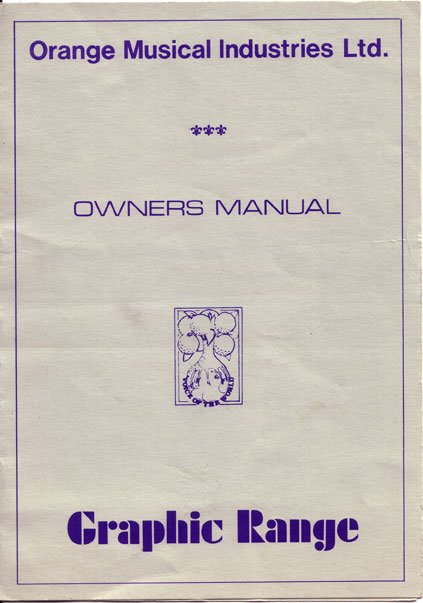
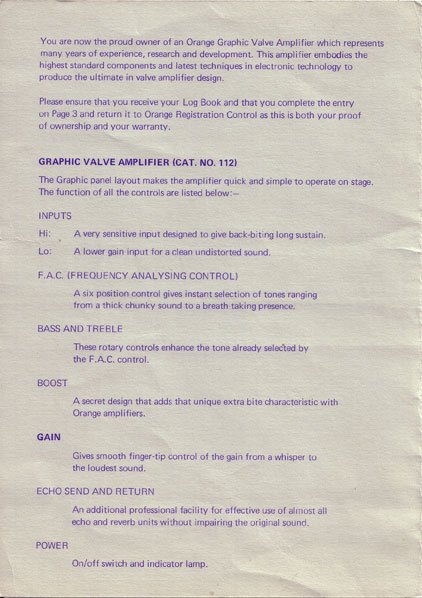
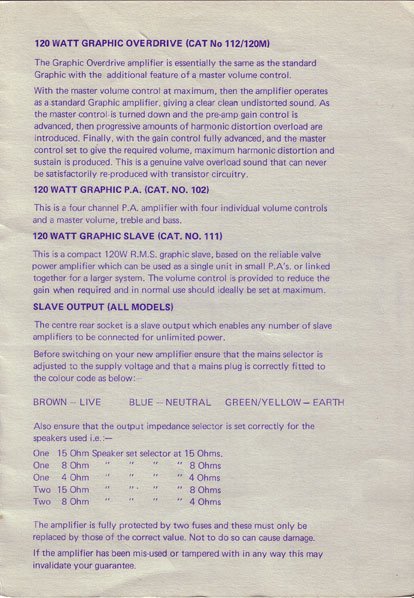
More Resources
Another great page to check out for more information on Orange Amplification is the Orange Amp Field Guide!



























